
Smilax are considered by many as out best spring time green. Photo by Green deane
Now is a good time to harvest smilax tips and Florida betony roots. As warm weather increases, the smilax tips tend to get peppery and bitter (and are better cooked than raw.) Betony tends to not store energy in the heat of summer, reducing their root size. Now, at the end of spring, good sized, pure white root can be dug up.
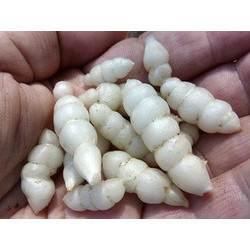
Betony root has a texture and flavor like a radish but no heat. Photo by Green Deane
Now is the time to inspect any Jambul Trees you know of. Their fruiting can vary as much a six weeks.If I had to guess I would suspect they will be early this year. August is their usual ripening time. Three years ago they were late because of light rains. Also called Java Plum or Jamun. The tree also demonstrates quite a few principles. One is that the toxin is often on the outside. Why? Because that is where insects, birds and other animals attack first. This is why green potatoes can make you sick if you eat the skins. In the case of the Jambul Tree the skin of the sweet fruit is loaded with tannin, about 10 times more than a red grape. So they are edible but there is a bitter astringency. Sprinkling with salt or soaking in salt can reduce that.
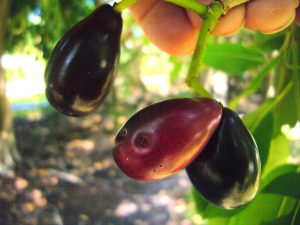
Even ripe Jambul fruit is slightly astringent. Photo by Green Deane
The major impediment to the tree — though it is a commercial fruit — is the tannins. Salt does mitigate that some when eating them fresh and is reported to lower blood glucose levels. Making wine out of the fruit is a challenge because of the tannin. Often when you make wine you have to add tannin. In this case one has to use strategies to reduce the tannin. This ranges from yeast selection to fining agents that grab onto the large tannin molecules and help them sink to the bottom so they can be left there. You can read about the Jambul Tree here.
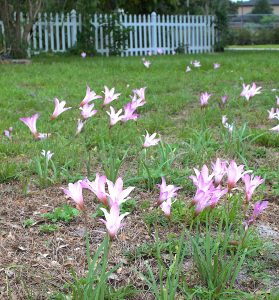
The Toxic Atamasco Lily. Photo by Green Deane
What are they? The first answer is they are NOT edible. The second is they are a threatened species. And the third answer is they are the toxic Atamasco lily, aka Rain Lily ( Zephranthes atamasca.) For a threatened species they are seen in a lot of lawns this time of year prompting many emails asking for an identification. These natives like wetlands but a well-watered lawn after seasonal rains will do nicely. The problem with the Atamasco is that it resembles wild garlic before it blossoms (and even has a bulb!) However, it does not have the telltale garlic aroma. Remember if it smells like a garlic AND looks like a garlic you can use it like a garlic. The Atamasco does not have any garlic/onion aroma. It is not edible. All parts are poisonous. Leave it alone. And while these in the picture have a pink tinge there are also all-white blossoms.
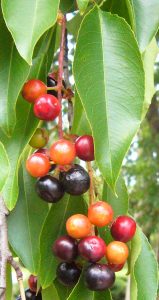
Black Cherries can still be found in season. Photo by Green Deane
Black Cherry has been mentioned a couple of times earlier this year and that’s the reason for it being mentioned now: It’s still fruiting. The season seems a bit longer this year than usual and I still see them here and there. It is safe to say Black Cherries look better than they taste. There is an initial cherry sweetness but then a residual bitterness takes over whereas chokecherries are bad start to finish. There were four of those trees on the other side of our lawn where I grew up in Maine. They were quite irritating: They looked wonderful but tasted awful (unless made into wine.) Black Cherries, like the chokecherries, are much better processed into jelly and jwine (or cough medicine from the cambium.) Do not eat the seeds. To read more about the Black Cherry go here.
Chamberbitters, Phyllanthus urinaria, is medicinal not an edible. We don’t cover herbals here because I am not qualified to talk about them much. However I know this one has a lot of good reserch behind it. This plant is a rich source of lignans, tannins, flavonoids, phenolics, terpenoids, and other secondary metabolites. Pharmacological activities include anticancer, hepatoprotective, antidiabetic, antimicrobial, and cardioprotective effects. As a point of identification note the seeds line up on the bottom of the stem. You can read about it here.
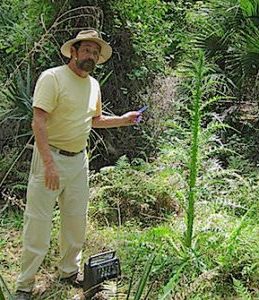
Foraging classes are held rain, shine, hot or cold. Photo by Nermina Krenata
Foraging Classes: Because of rennovations, we have to meet at a different location at Red Bug Slough in Sarasoata. Normally it is at 5200 S. Beneva Road. Instead we will have to park at Gypsy Street and South Lockwood Ridge Road. Gypsy can be reached by Camphor Ave which runs south of Proctor west of Beneva.
June 10, Colby-Alderman Park: 1099 Massachusetts Street, Cassadaga. Fla. 9 a.m., meet at the bathrooms.
June 11, Red Bug Slough , Sarasota. 9 a.m. Because of rennovations, we have to meet at a different location at Red Bug Slough in Sarasoata. Normally it is at 5200 S. Beneva Road. Instead we will have to park at Gypsy Street and South Lockwood Ridge Road. Gypsy can be reached by Camphor Ave which runs south of Proctor west of Beneva.
June 17, George LeStrange Preserve, 4911 Ralls Road, Fort Pierce, FL 9 a.m.
June 18, Blanchard Park, 2451 Dean Rd, Union Park, FL, meet next to the tennis courts. 9 a.m.
Bring cash on the day of class or click here to pay for your class
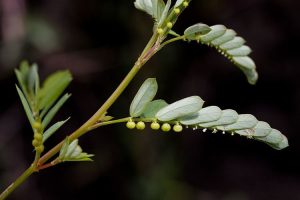
Chamberbitter, Phyllanthus urinaria.
Chamberbitters, Phyllanthus urinaria, is medicinal not an edible. We don’t cover herbals here because I am not qualified to talk about them much. However I know this one has a lot of good reserch behind it. This plant is a rich source of lignans, tannins, flavonoids, phenolics, terpenoids, and other secondary metabolites. Pharmacological activities include anticancer, hepatoprotective, antidiabetic, antimicrobial, and cardioprotective effects. As a point of identification note the seeds line up on the bottom of the stem. You can read about it here.

You get the USB, not the key.
My nine-DVD set of 135 videos has been phased out and replaced by 171-videos on a 128-GB USB, see right. The USB videos are the same videos I have on You Tube. Some people like to have their own copy especially if social order falters. The USB videos have to be copied to your computer to play. If you want to order the USB go to the DVD/USB order button on the top right of this page or click here. That will take you to an order form. Or you can make a $99 donation, which tells me it is for the USB (include a snail-mail address.) I’d like to thank all of you who ordered the DVD set over the years which required me to burn over 5,000 DVDs individually. I had to stop making them as few programs now will read the ISO files to copy them. Burning a set also took about three hours.

Green Deane Forum
Want to identify a plant? Perhaps you’re looking for a foraging reference? You might have a UFO, an Unidentified Flowering Object, you want identified. On the Green Deane Forum we — including Green Deane and others from around the world — chat about foraging all year. And it’s not just about warm-weather plants or just North American flora. Many nations share common weeds so there’s a lot to talk about. There’s also more than weeds. The reference section has information for foraging around the world. There are also articles on food preservation, and forgotten skills from making bows to fermenting food. Recent topics include: Stale Bread and Cod Liver Oil, Killing Bugs with Tobacco Plugs, Eating weeds: Is it safe? Have they mutated? Not the Eastern Red Bug but the Pink Tabebuia, African Tulip Tree, Asparagus densiflorus, Green Deane’s Book… You can join the forum by clicking on the button on the upper right hand side of this page.
This is my weekly newsletter #561. If you want to subscribe to this free newsletter you can find the sign-up form in the menu at the top of the page. My website, EatTheWeeds.com, which is data secure, has over 1500 plants on it in some 428 articles. I wrote every one myself, no cut and paste.
To donate to the Green Deane Newsletter click here.

